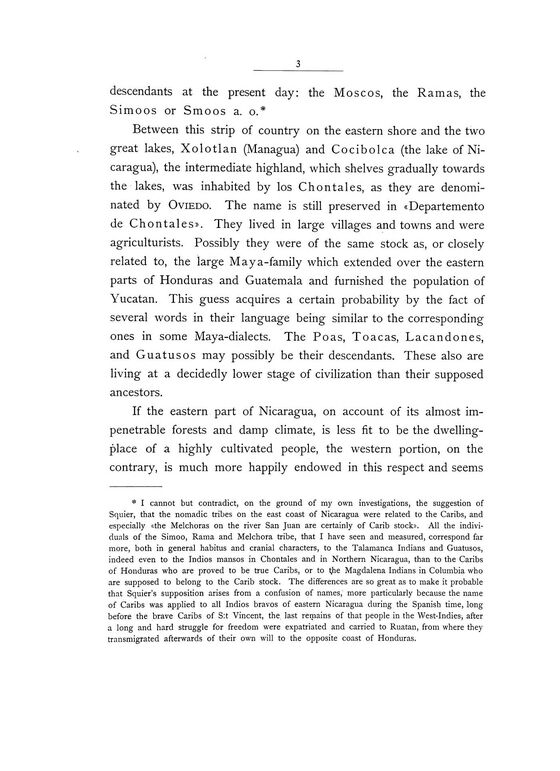
Full resolution (JPEG) - On this page / på denna sida - Sidor ...

<< prev. page << föreg. sida << >> nästa sida >> next page >>
Below is the raw OCR text
from the above scanned image.
Do you see an error? Proofread the page now!
Här nedan syns maskintolkade texten från faksimilbilden ovan.
Ser du något fel? Korrekturläs sidan nu!
This page has never been proofread. / Denna sida har aldrig korrekturlästs.
descendants at the present day: the Moscos, the Ram as, the
Simoos or Smoos a. o.*
Between this strip of country on the eastern shore and the two
great lakes, Xo loti an (Managua) and Cocibolca (the lake of
Nicaragua), the intermediate highland, which shelves gradually towards
the lakes, was inhabited by los Chon tales, as they are
denominated by Oviedo. The name is still preserved in «Departemento
de Chontales». They lived in large villages and towns and were
agriculturists. Possibly they were of the same stock as, or closely
related to, the large Maya-family which extended over the eastern
parts of Honduras and Guatemala and furnished the population of
Yucatan. This guess acquires a certain probability by the fact of
several words in their language being similar to the corresponding
ones in some Maya-dialects. The Poas, Toacas, Lacandones,
and Guatusos may possibly be their descendants. These also are
living at a decidedly lower stage of civilization than their supposed
ancestors.
If the eastern part of Nicaragua, on account of its almost
impenetrable forests and damp climate, is less fit to be the
dwelling-place of a highly cultivated people, the western portion, on the
contrary, is much more happily endowed in this respect and seems
* I cannot but contradict, on the ground of my own investigations, the suggestion of
Squier, that the nomadic tribes on the east coast of Nicaragua were related to the Caribs, and
especially «the Melchoras on the river San Juan are certainly of Carib stock». All the
individuals of the Simoo, Rama and Melchora tribe, that I have seen and measured, correspond far
more, both in general habitus and cranial characters, to the Talamanca Indians and Guatusos,
indeed even to the Indios mansos in Chontales and in Northern Nicaragua, than to the Caribs
of Honduras who are proved to be true Caribs, or to t,he Magdalena Indians in Columbia who
are supposed to belong to the Carib stock. The differences are so great as to make it probable
that Squier’s supposition arises from a confusion of names, more particularly because the name
of Caribs was applied to all Indios bravos of eastern Nicaragua during the Spanish time, long
before the brave Caribs of S:t Vincent, the last remains of that people in the West-Indies, after
a long and hard struggle for freedom were expatriated and carried to Ruatan, from where they
transmigrated afterwards of their own will to the opposite coast of Honduras.
<< prev. page << föreg. sida << >> nästa sida >> next page >>